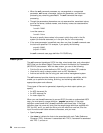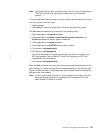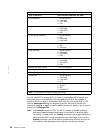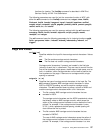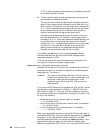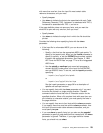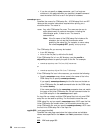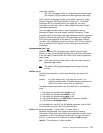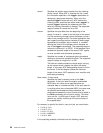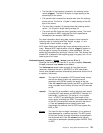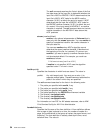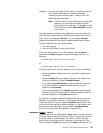(X'F0'), which represents double spacing, the double spacing will
occur
before
the line is printed.
m The file contains machine code carriage-control characters that
are encoded in hexadecimal format.
The use of machine code carriage-control characters cause the
action of the carriage-control character to occur
after
the line of
data is printed. For example, if the carriage-control character is a
X'11', which represents double spacing, the line will be printed
and the double spacing will occur
after
the line is printed. In
addition, machine code carriage-control has a set of
carriage-control characters that perform the action, but do not
print the associated line. For example, if the carriage-control
character is a X'13', which also represents double spacing, the
print position will be moved down two lines but the line that
contains the X'13' carriage-control character will not be printed.
The next line in the data will be printed at the current print
position and the action for the associated carriage-control
character will be performed
after
the line is printed.
If you specify cc=yes but you do not specify cctype, the acif
command assumes that the file contains ANSI carriage-control
characters encoded in ASCII.
If you are not sure which type of carriage-control characters are in
your input file, consult your system support group.
chars=
fontname1, fontname2, fontname3, fontname4
Specifies the file name of from one to four coded fonts to be used in
processing the print file. A coded font specifies a character set and
code page pair. The value is:
fontname
The name of the desired coded font. The font name is
limited to four alphanumeric or national characters, and
should not include the two-character prefix of the
coded-font name (X0 through XG). The font name is
case-sensitive.
If you use the ASCII fonts that are supplied with PSF for AIX, use the
four-character names as shown in Chapter 5, “IBM AFP Fonts for
ASCII Data” on page 77. If you use your own coded font that has a
file name with more than six characters (including the X
n
prefix), then
do one of the following:
Rename the font file to a shorter name. For example,
– mv X4232 X422
Copy the font file to a file that has a shorter name. For example,
– cp X4232 X422
Link the original font file to a shorter name. For example,
– ln -s X4232 X422
When you use the acif command to convert S/370 line-mode data or
unformatted ASCII data, you must specify a page definition ( pagedef
parameter). If the page definition names some fonts, the acif
command uses those fonts, and ignores the chars parameter. If the
page definition does not name any fonts (like the sample page
definitions supplied with PSF for AIX), and if you want the file to print
28 ACIF User’s Guide







